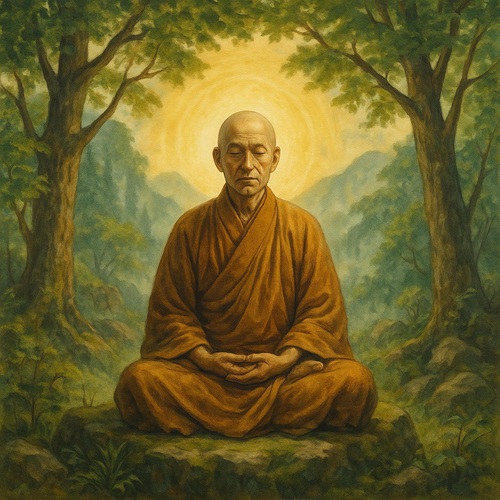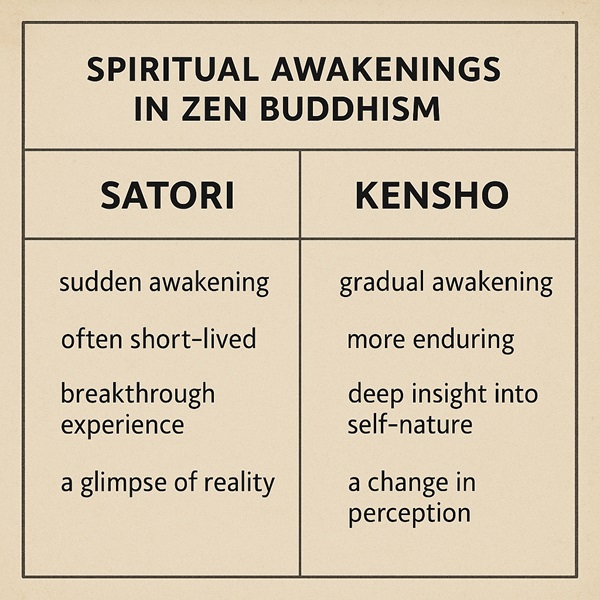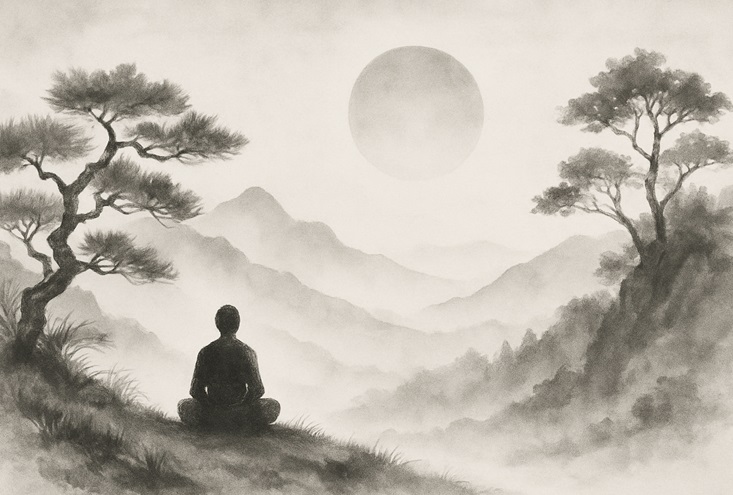Satori vs. Kensho – Different Forms of Awakening
Lately, I have found myself deeply fascinated by spiritual awakening experiences, especially within the context of Buddhism. Over the past few weeks, two terms have repeatedly captured my attention, Kensho and Satori. If you’ve ever wondered about the difference between Kensho vs Satori in Zen Buddhism, or how these powerful experiences of awakening can shape your spiritual journey, this post is for you.
My curiosity about these concepts was sparked unexpectedly. One ordinary morning last month, I was sipping my usual coffee, sitting in front of my laptop, when I stumbled across a video featuring the Michael Bernard Beckwith. Something in his message struck a deep chord with me—it felt as though my inner world was being nudged awake. That moment led me down a path of exploration, reading, and introspection that I have continued to walk since.
Interestingly, while reading Joe Vitale’s Zero Limits, the term Satori popped up again. It felt like the universe was trying to tell me something. That’s when I decided to dive deeper and write this blog post to help others better understand these two profound states of consciousness.
Along the way, I realized that I had experienced what could be described as Satori, a brief but impactful glimpse into the nature of reality that left a lasting impression on me. I’ll be sharing more about that personal experience later in the post, along with the traditional definitions, key differences, and deeper meaning of Kensho and Satori in the Buddhist tradition.
So, whether you’re on your own path to awakening or simply curious about these terms, read on to discover the essence of Kensho and Satori—and how they may already be showing up in your life, too.
Note: This post was originally written on June 27, 2016 and fully updated in July 2025.
Two Types of Awakening According to Zen Buddhism
You can never predict how, when, or where someone might experience a spiritual awakening, or whether they will experience it at all.
Many spiritual traditions suggest that awakening is a process that unfolds over multiple lifetimes. However, one thing we can say with some certainty is this: there are two primary ways in which a person can catch a glimpse of the highest Truth.
In Zen Buddhism, the terms Kensho and Satori are often used to describe these two distinct types of spiritual awakening experiences. While they represent different approaches or moments along the path, both ultimately lead to the same destination—enlightenment.
Let’s now take a deeper look into each of these profound awakenings and understand what makes them unique.
Satori Meaning
In Zen Buddhist terminology, Satori refers to a sudden and powerful spiritual awakening experience. It is a moment of profound clarity where a person becomes acutely aware of the truth and sees reality exactly as it is, i.e free from mental filters, ego, or interpretation.
Satori is often described as a fleeting but intense glimpse into the ultimate truth, like the curtain briefly lifting to reveal the deeper nature of existence. It’s not a permanent state of enlightenment, but rather a short-lived flash of insight that leaves a lasting impact.
This moment of realization can feel like a sudden burst of realization moments where every spiritual knowledge is no more a concept but you actually understand what it meant and the illusions of the mind dissolve, even if only temporarily. It’s a powerful step on the spiritual path that points toward deeper, more sustained awakening.
Kensho Meaning
In Zen Buddhism, Kensho is described as a gradual process of experiences and realizations that lead to the revelation of the ultimate truth. It represents the spiritual evolution that we all go through. Rather than a sudden awakening, Kensho is a step-by-step journey where a person learns from their experiences and gains various insights that slowly guide them toward enlightenment.
It’s like running a marathon, which means through mistakes, suffering, and pain, you grow stronger and wiser, gradually becoming better than before.
However, just as Shree Krishna tells Arjuna at the end of the Bhagavad Gita to forget everything he has taught, there is a deeper lesson here. Krishna urges Arjuna to leave behind all dualities like right or wrong, good or bad, true or false, and to take complete refuge in him.
This is a profound parable for letting go of all concepts and mental tools, including our judgements and attachments to knowledge, as ultimately, true liberation lies beyond these distinctions. Similarly, on the path to Nirvana, we must release all the tools and frameworks that initially guided us, surrendering to a state beyond dualistic thinking.
Difference Between Satori and Kensho
Although Satori and Kensho are both spiritual awakening experiences in Zen Buddhism, they represent different paths toward the same ultimate destination, enlightenment. You can think of it like this: Kensho is like slowly opening a book and absorbing the story through its chapters, while Satori is like suddenly jumping ahead and reading the climax. Both are powerful, but one feels incomplete without the other.
Kensho is a gradual process of insight, where through life’s challenges and experiences, you steadily uncover deeper truths. This ongoing journey often leads to moments of Satori, a sudden, intense awakening where you glimpse the ultimate reality in a flash.
On the flip side, Satori without the foundation of Kensho can feel fleeting or temporary, because it lacks the depth that comes from continuous growth and understanding.
From this, we can infer that enlightenment can emerge in two ways: either through the pain and learning of a slow, evolving process, or through the sudden clarity of insight. However, it’s important to remember that neither state is permanent. These experiences are stepping stones, glimpses into awakening that inspire and guide us further along the spiritual path.
Although Satori is considered the final milestone, certain typical moments, like near-death experiences, intense physical or mental suffering, or even deep meditation sessions can cause temporary glimpses into the ultimate truth. However, such moments often don’t last long because, for Satori to be the lasting and transformative experience it is meant to be, you need to have travelled the Kensho path well.
What Can You Do to Get Spiritually Awakened?
We can see in the lives of many famous spiritual masters that they went through extreme physical or mental anguish before attaining enlightenment. A great example is the modern-day spiritual teacher Eckhart Tolle.In his acclaimed book The Power of Now, he describes how immense emotional suffering triggered a sudden shift in his perception, leading to the realization of his true nature..
However, it is not necessary to experience hardship to receive spiritual insights. Sometimes, people who cultivate present-moment awareness through meditation or mindfulness enter a thoughtless state where profound spiritual insights naturally arise. There is no quick or magical formula to make awakening happen.
The key is to become a more aware person by regularly practicing meditation or mindfulness exercises, which will help you advance spiritually over time.
It may seem unfair to some spiritual seekers that others, who have never focused on spiritual growth, can have these insights easily, while those who meditate daily for years may not. The truth is, both Satori and Kensho can happen to anyone, regardless of effort. In fact, many people who desire these experiences never receive them.
There have even been enlightened individuals throughout history who showed no interest in liberation. Why is this? Because the desire for enlightenment itself can block the recognition of the truth, which is always present in the now moment.
If your spiritual practices are aimed at reaching some future state, awakening will always remain a distant goal. Instead, your focus should be on becoming more present in each moment. This alone can greatly improve your emotional well-being and spiritual progress.
Setting the goal to “get enlightened” can actually hinder your growth and reduce the effectiveness of your practices.
So, what can you do to get awakened? The answer is nothing.
Nothingness is the key to enlightenment. It means detaching yourself from everything happening inside your mind. Even attachment to the desire for liberation is one of the main obstacles to progress.
My Personal Experience and Final Thoughts
After practicing present moment awareness regularly through various mindfulness exercises, something extraordinary happened one day. I experienced a moment of intense silence. For a brief instant, “I” was no longer there. The usual sense of self, the psyche, had disappeared. There was no experiencer. Things simply were, just as they are. The identity I usually associate with myself was gone, and only “all that is” remained.
It felt like I had touched a truth that had always been present. It was something so basic and simple, yet it had been ignored for so long. Trying to explain the experience is nearly impossible, because now it only exists as a memory, a thought, an impression left with a “person.” Still, I can honestly say it was a moment of Satori.
Since that day, I’ve been trying to understand what exactly happened, but what matters most is the deep confidence it gave me. That experience confirmed for me that the teachings about the ultimate truth are not just philosophies. They are real.
Despite that realization, I found myself still attached to the idea of enlightenment. That desire kept growing stronger until eventually, it backfired. The result was a series of uncomfortable and undesirable mental states.
From that experience, I’ve learned an important lesson. Now I practice meditation and mindfulness not to become enlightened, but simply to become a more emotionally healthy and balanced person.
If my story doesn’t make the point clear enough, consider the journey of the Buddha himself. He too had to learn, through his own suffering, that the path to awakening requires letting go of the desire to become enlightened.
Whether it is Satori or Kensho, both experiences allow you to feel your oneness with “all that is.” But instead of chasing after awakening, focus on cultivating inner peace in your life. Let awakening happen naturally, in its own time.
Thank You for Reading
I hope this post offered you something meaningful. I would truly love to hear your thoughts, insights, or questions. Please feel free to leave a comment in the box below. Your feedback helps motivate me and allows me to improve the content on this blog.
If there’s anything I missed or if you would like to connect personally, you can reach out through the contact page. I’m always happy to help with anything I can.
If you feel inspired to dive deeper into your own spiritual journey and clarify your higher purpose, I highly recommend checking out Mindvalley’s Life Visioning Mastery program by Michael Bernard Beckwith. This powerful course guides you through a process of awakening using his renowned Life Visioning method, helping you align with the highest vision for your life—not through chasing goals, but by allowing your soul’s purpose to unfold naturally.
And if you found this post helpful, please consider sharing it on your favorite social media platforms. It helps spread the message and reach more people who might benefit from it.
Frequently Asked Questions (FAQ)
What is the difference between Satori and Kensho?
Satori is a sudden, spontaneous glimpse into your true nature or the ultimate reality. It often comes unexpectedly and is characterized by a moment of profound clarity and ego dissolution, where everything simply “is” without the interference of the mind or identity.
Kensho, in contrast, is usually a more gradual and unfolding realization. It involves a growing insight into the nature of the self and reality over time. While Kensho can still be powerful, it is often less dramatic than Satori and marks the beginning of a deeper inner journey rather than a complete breakthrough.
Both are forms of spiritual awakening, but they differ in how the realization occurs—Satori is sudden, while Kensho is progressive.
What are the different types of spiritual awakenings?
Spiritual awakenings can vary greatly depending on the individual and tradition, but some commonly described types include:
- Kensho: An initial insight or opening into your true nature, a gradual inner transformation.
- Satori: A deeper realization of non-duality and the dissolution of ego, a sudden insight.
Each type can serve as a stepping stone toward deeper understanding and inner peace.
Can Satori be experienced by anyone?
Yes, Satori can be experienced by anyone. It is not limited to monks, mystics, or spiritual teachers. With sincere practice in mindfulness, presence, and self-inquiry, even ordinary people can have moments of Satori. However, the experience is spontaneous and cannot be forced—it happens naturally when the psychological “self” temporarily dissolves.
Can meditation lead to Satori?
Yes, meditation can create the conditions for Satori to occur. Regular mindfulness and meditation practices help quiet the mind and reduce identification with the ego. By staying fully present in the moment, you may experience a state of inner stillness where the illusion of separateness drops away. While meditation doesn’t guarantee Satori, it significantly increases the likelihood of experiencing such profound shifts in awareness.

